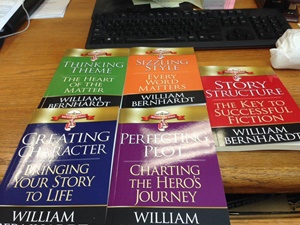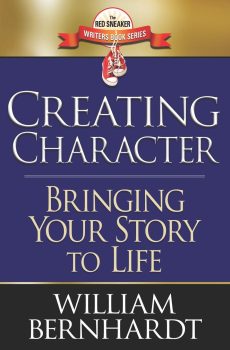Writing Advice: Creating Character (Red Sneaker Writers)
It’s been a year, so let’s look at another volume of William Bernhardt’s awesome Red Sneaker Writers books. These things are absolute treasures.
I started reading William Bernhardt’s Ben Kincaid books back in the mid-nineties. I seem to recall I went on a ‘lawyer’ kick and read him, Steve Martini, and Robert K. Tannenbaum, all around the same time. But years later, Bernhardt made a bigger impact on me with his Red Sneaker Writers series. These slim volumes with the brightly attractive colors are jam-packed with great writing advice. The first book I read was on story structure, and I think it’s still my favorite. Though every one has been both interesting to read and thought-provoking. If I ever get my act together, I’ll add “taught me a lot.”
I’ve read through a couple of them more than once, making notes on paper (I CANNOT highlight a physical book. I’m incapable of it). Last year, I decided to be a little more systematic and I went through EVERY title, be it Theme, Plot, Character – all of them: and I outlined the key points in each chapter. I printed them all out and have a very cool binder. Which, if I ever actually sit down and write a novel, will be of great use.
I sent one of the outlines to him, telling him that I’d like to include it in a Black Gate post, promoting the series. He kindly granted his permission. Today, it’s the third outline in this series.
I’m fortunate that many actual, real, Writers (note the capital ‘W’) with books you can buy on Amazon, or at bookstores (if you can find one that is still in business), are friends of mine. And they are FAR more qualified than I am to talk abut writing advice. I think I hold my own as a Black Gate blogger, and there are worse Sherlock Holmes short stories out there than mine (And certainly better ones!). But my unfinished novel is just a bunch of words strung together, until I finish it.
But I’ve read a lot of books on writing – fiction and screenplays. And I’ve come across a lot of useful ideas, suggestions, thoughts, and advice, from folks such as Lawrence Block, Tony Hillerman, William Martell, Syd Field, Robert Randisi, Chris Vogler (though I’m more apt to go to the original source material from Joseph Campbell), and James Scott Bell – to name a few without actually looking at my bookshelves. There are quite a few more, but my education would be incomplete without the Red Sneaker Writers books from Bernhardt. He writes in a clear, amusing, understandable, useful, manner. I can’t imagine not picking up at least something from each book. And I think you’re going to learn more than that.
 He starts each chapter with a neat quote. And each chapter ends with a couple Highlights, which I think of as Key Points. And also a couple of exercises to help you move forward. For each book, I took all the Key Points and turned them into an outline. And I spaced them out, so that I can write notes and comments in them. I’m pretty pleased with myself!
He starts each chapter with a neat quote. And each chapter ends with a couple Highlights, which I think of as Key Points. And also a couple of exercises to help you move forward. For each book, I took all the Key Points and turned them into an outline. And I spaced them out, so that I can write notes and comments in them. I’m pretty pleased with myself!
So what follows, is my outline for Creating Character: Bringing Your Story to Life. Of course, reading the book is much better, but what I wanted to do with this post was give you an idea of what one of the books contains. And what you can learn from it. I like Bernhardt’s tone, and sense of humor. Which makes learning easier for me. Except that I’m so thick-headed…
So, go ahead and read on through this outline. And check out all the books at his web page. Plus his other works, of course! You can subscribe to his free Red Sneaker Writers newsletter. I have all of the books in paperback, and they’re TOTALLY worth $7.99 each. The ebooks are between $2.99 and $4.99, and I HIGHLY suggest finding one or two that you want to check out and giving them a try. For me, Story Structure, and Character, are the two more ‘building blocks’ books, with the others to improve my writing ability. But you can start anywhere.
And since I started outlining these, Bernhardt recorded each one as audiobooks. I bought Story Structure, and it’s a good listen. As you know, you can’t always read; the complaints from the people I drive in my carpool… ha ha ha. So, check out a volume in print, digitally, or listen to it. I think you’ll want to get another one.
Links to the prior installments – as well as other writing thoughs I’ve had – below.
CREATING CHARACTER – BRINGING YOUR STORY TO LIFE
I – CHARACTER IS CRITICAL
1 – Regardless of what kind of story you are writing, memorable characters are essential.
2 – All stories are character-driven.
3 – Character and plot are two closely interrelated ways of viewing the same thing: your story.
II – CHARACTER AS METAPHOR
1 – Characters are not real people. They are metaphors.
2 – Do not base your protagonist solely upon yourself.
3 – Do not base any of your other characters solely upon anyone.
4 – Let your main character embody a virtue or principle that connects thematically to what you want your book to represent.
III – CHARACTER AND CHARACTERIZATION
1 – Characterization is the observable details. Character is who they really are.
2 – Characterization should provide insight into who the character really is.
3 – Don’t waste your reader’s time with characterization that does not provide insight into who the character is.
IV – CHARACTER IS CHOICE
1 – Character is revealed by choices made under pressure.
2 – The greater the pressure, the deeper the revelation.
3 – Characters should undergo increasingly difficult pressures resulting in increasingly difficult pressures resulting problems that reveal their true natures.
4 – Special traits and abilities can make your characters more appealing while also giving the reader additional insight into who they really are.
5 – Larger-than-life characters delight readers because they do, say and grow in ways that we cannot.
6 – Your book is not going to capture a reader’s imagination unless there is something out of the ordinary about the characters in their story.
V – CHARACTER AND CONTRADICITION
1 – Contradiction, internal or external, makes characters more interesting. This is the fundamental quality found in three-dimensional characters.
2 – Not all characters need to be three-dimensional.
VI – CONSIDERING THE PROTAGONIST
1 – The protagonist must haves a goal or desire, a chance to obtain it, and something that makes him/her/it appealing to the reader.
2 – Your protagonist must be sympathetic or empathetic.
3 – Protagonists do not have to be flawless to be likeable.
4 – The antagonist must haves a goal or desire, a chance to obtain it, and something that makes him/her/it appealing to the reader.
5 – The best antagonists have strong and understandable motivations for the actions they take in opposition to the protagonist.
VII – VIEWPOINT
1 – You are always writing in someone’s viewpoint.
2 – Put as little distance as possible between your reader and viewpoint characters.
VIII – MAKE READERS CARE
1 – Readers must like your protagonist, either because of who they are or despite who they are, or both.
2 – Readers tend to admire characters who exhibit the following traits: excellence in their work, sense of humor, kindness, triumph over adversity, affection toward and with others, and forgiveness.
IX – CHARACTER ARC
1 – A character arc reveals the change a character undergoes in the course of the story.
2 – Most character arcs involve a dialectical journey from one place to its opposite, i.e., from innocence to maturity, or from ignorance to wisdom.
3 – Even series characters should have character arcs.
APPENDICES
I didn’t talk about the Appendices in the prior entries. I shall remedy that.
APPENDIX A – CHARACTER DETAIL SHEET
55 questions to develop your character-driven
APPENDIX B – THE WRITER’S CALENDAR
This has been in multiple books. A week-by-week layout to complete your novel in six months.
APPENDIX C – THE WRITER’S CONTRACT
This has also been in multiple books. It’s an agreement with yourself, to commit to the book – and to also take care of yourself while doing so.
APPENDIX D – THE WRITER’S READING LIST
Multiple books again. Several useful references.
Other Posts on Writing
Red Sneaker Writers: Structuring Your Story
Red Sneaker Writers: Perfecting Plot
Red Sneaker Writers: Dynamic Dialogue
Ya Gotta Ask – My Writing Career
RPGing is Storytelling
Don’t Start at the Start

Bob Byrne’s ‘A (Black) Gat in the Hand’ made its Black Gate debut in 2018 and has returned every summer since.
His ‘The Public Life of Sherlock Holmes’ column ran every Monday morning at Black Gate from March, 2014 through March, 2017. And he irregularly posts on Rex Stout’s gargantuan detective in ‘Nero Wolfe’s Brownstone.’ He is a member of the Praed Street Irregulars, and founded www.SolarPons.com (the only website dedicated to the ‘Sherlock Holmes of Praed Street’).
He organized Black Gate’s award-nominated ‘Discovering Robert E. Howard’ series, as well as the award-winning ‘Hither Came Conan’ series. Which is now part of THE Definitive guide to Conan. He also organized 2023’s ‘Talking Tolkien.’
He has contributed stories to The MX Book of New Sherlock Holmes Stories — Parts III, IV, V, VI, XXI, and XXXIII.
He has written introductions for Steeger Books, and appeared in several magazines, including Black Mask, Sherlock Holmes Mystery Magazine, The Strand Magazine, and Sherlock Magazine.
You can definitely ‘experience the Bobness’ at Jason Waltz’s ’24? in 42′ podcast.

Thanks for the article, Bob. I have purchased a couple of the Red Sneakers books based on your articles and will probably eventually get around to purchasing this one. Regarding the notes from the book. I question whether the ones regarding the likability of a protagonist and or that protagonist being sympathetic/empathetic is still a requirement. I have put down a number of books after 50 pages because there is not a character that I like/can root for But perhaps that is just my taste. I am reminded Joe Abercrombie’s First Law trilogy. He had introduced the main group of characters and a few were likeable but in the second book “Before They Are Hanged” all the whole group did was complain and snipe at each other, making every character unlikable. Maybe they redeemed themselves in the 3rd book, but I had no urge to read it. Thanks again.
Hi Jim.
I know that Blake Snyder built an empire on the concept of the protagonist doing something to make the viewer like them. They ‘save the cat.’
I wrote a post on how House of Cards turned that on its head.
https://www.blackgate.com/2014/04/09/house-of-cards-kicked-the-cat/
I generally want someone to root for/like. I find myself actually rooting against the main character when I don’t like them. Or I think they deserve a ‘comeuppance.’
Dark fantasy has more questionable heroes, by its nature. And I know of some TV shows with terrible people as the main character, but I don’t watch those.
I think there’s still a way broader appeal when you are sympathetic/empathetic to the main character.
Just my sense.